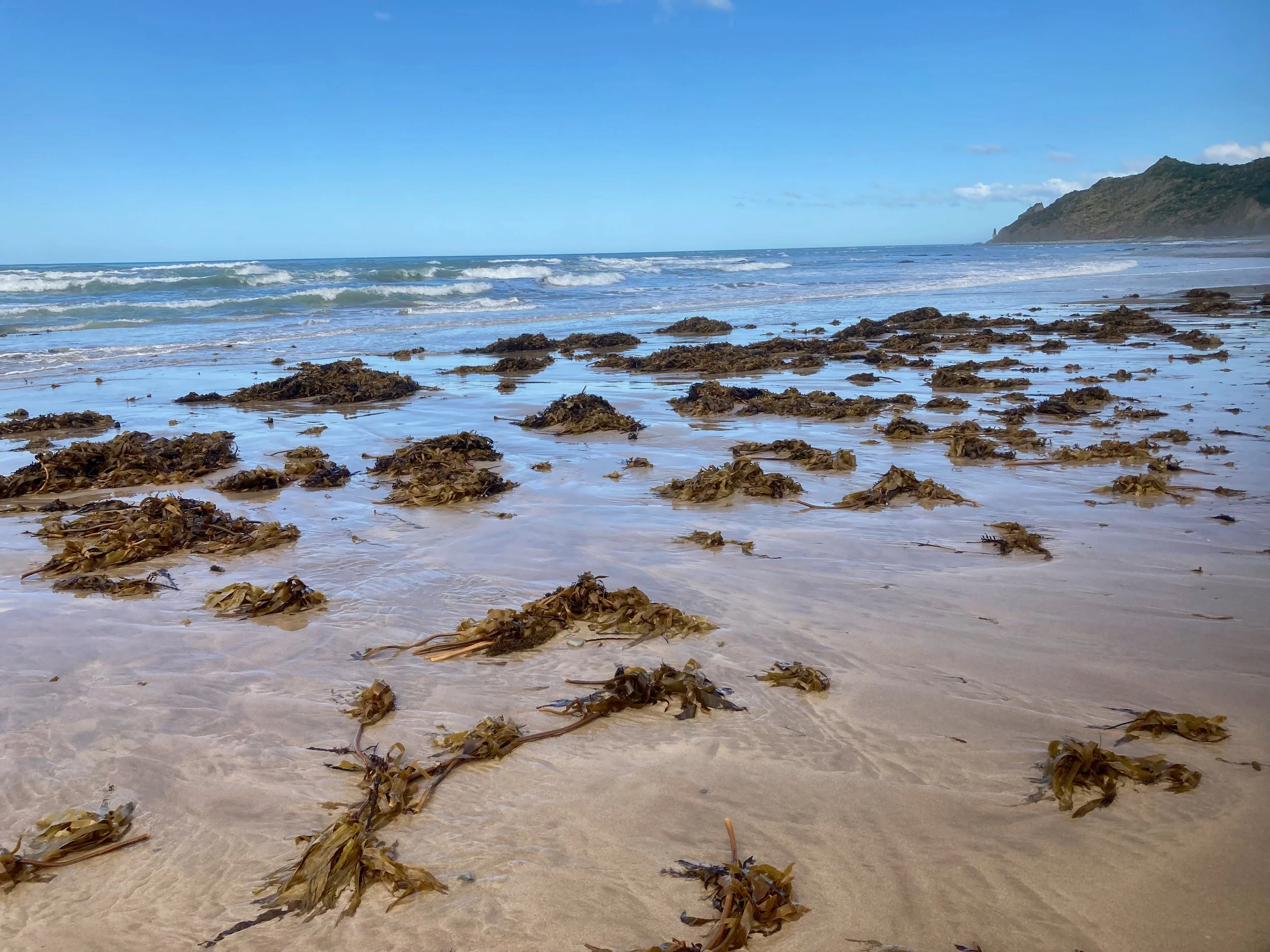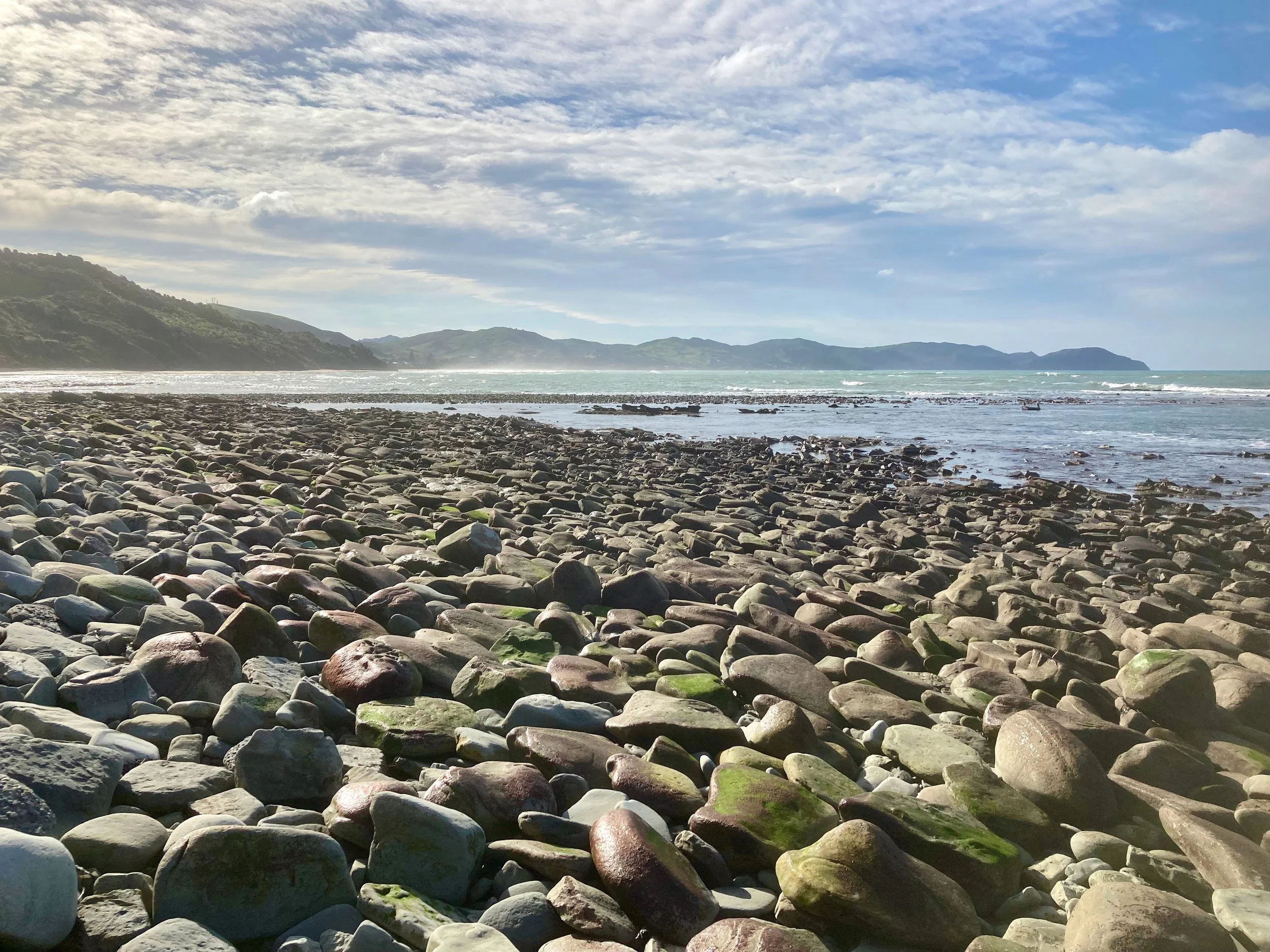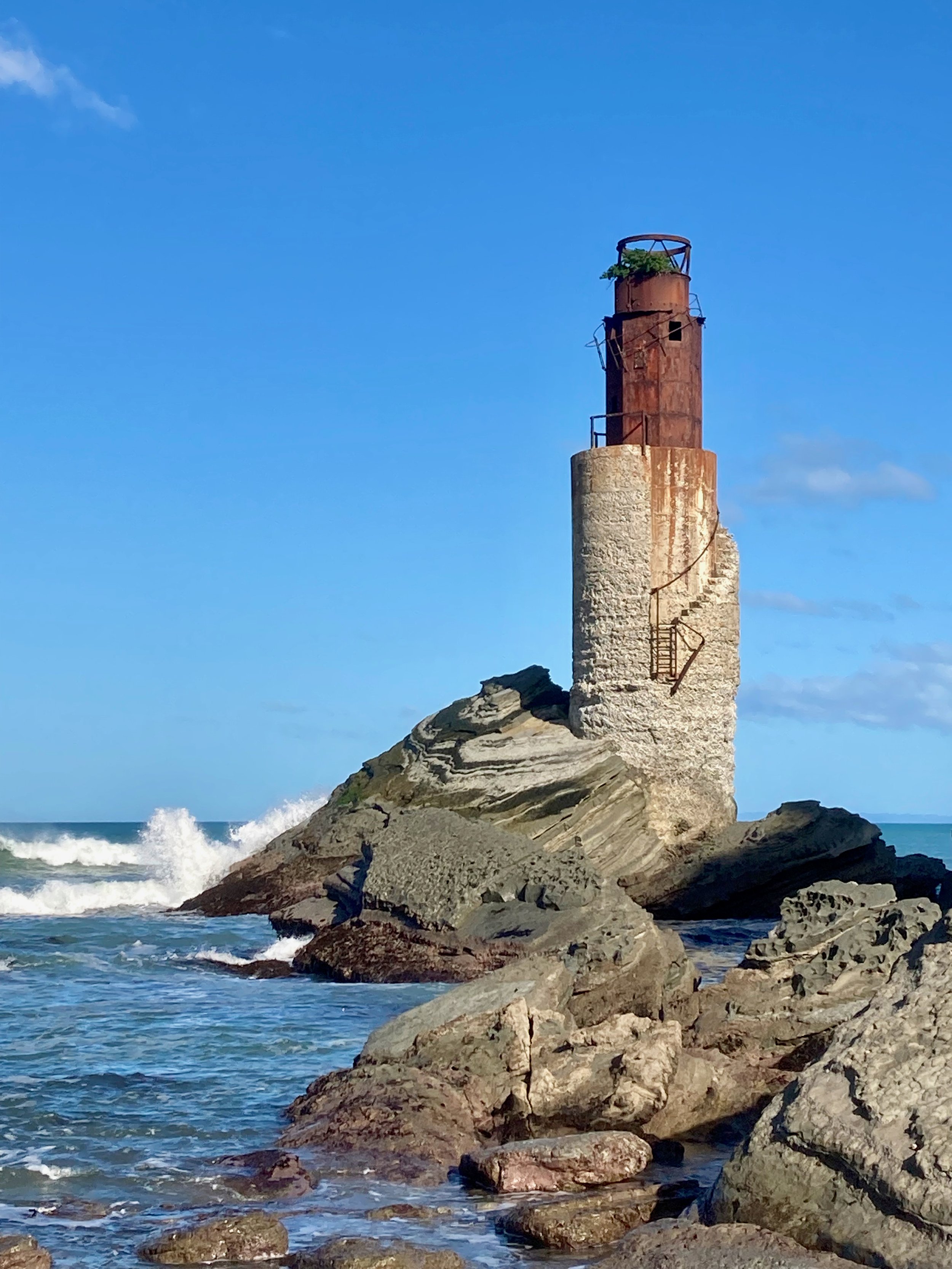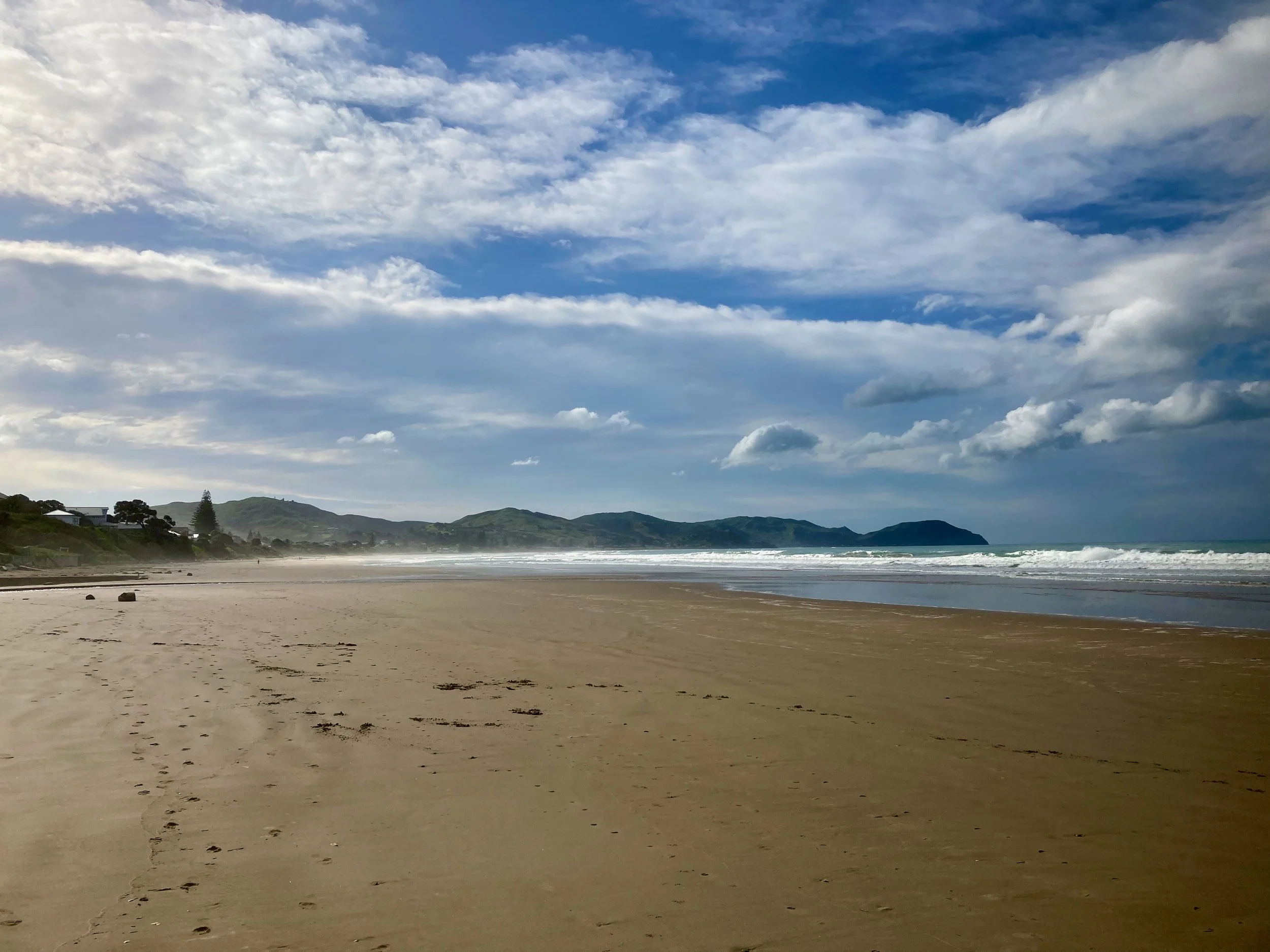Insulation
I walked through our backyard, out the gate, and down the public access path to the beach. As soon as I rounded the corner of the hedge, the expanse of ocean came into view and the wind hit me full in the face. I was glad I had put on my winter coat, though it felt a bit odd to wear it with my swimsuit and sandals. I suppose I hardly looked out of place here in our little corner of New Zealand, where kids frequently walk to school barefoot even in the depths of winter. I thought about waiting for a warmer day, but spring was a long way off. It was the first time in the month since we had arrived that there was a low tide in the middle of a day off, and I was going to seize the opportunity, no matter the weather.
So I waded through the shallow but frigid waters of Wainui Stream where it cuts a channel across the beach and headed south along the firm, cold sand. With the tide out, I could finally pass the seawall that stuck out into the sand just south of the stream. Until that low tide, the concrete wall had marked the southern limit of my beach walks as it was usually surrounded by swirling waters and crashing waves. But today, I walked around the end of the wall and to the bay beyond.
The strand ahead curved back into the shore beneath steep hills of pasture and untamed bush that met the ocean at weathered cliffs that exposed the layered rock beneath. To my left, the waves crashed on a series of rocky reefs well back from the beach, leaving a series of long, linear tide pools in between. But evidence of high tide remained, with bundles of tangled kelp strewn about the beach. A pair of black oystercatchers drilled for food in the wave-washed sand. And ahead, I could see beyond the end of the bay my destination: the lighthouse at Tuaheni Point.
Ever since we had arrived I had been drawn to the lighthouse. The rusty spire perched on a pinnacle of rock is visible from nearly everywhere along the curve of Wainui and Okitu beaches. Even back in the US I had gazed at pictures of the lighthouse on Google maps as we prepared for our move. I was drawn by the dramatic, rugged coastline and that strange magnetism of old lighthouses, those lonely outposts of functional, steadfast brilliance. I had figured I would have to befriend someone with a boat to see it close up, but a neighbor said it was possible to walk there if you had a few hours around a low tide. She warned me to bring footwear, as the second half of the walk changes from sandy beach to rocky shore.
And so I found myself trudging barefoot along a new stretch of sand into a fierce fall headwind, carrying my sandals, while the grey-green surf pounded itself into a froth under pale blue skies. When the sand ended, I rinsed my feet in a small tidepool and slipped on my sandals, then picked my way carefully along the jumble of stones and rock outcroppings. I rounded a bend into the full force of the wind and the lighthouse, which had been hidden behind the high hills above, reappeared just ahead. It was framed by eroding cliffs crowned with a vivid green carpet that brought my mind back to the West coast of Ireland, that aptly-named Emerald Isle.
I scrambled over the rocks toward the lighthouse until I reached a ridge of rock that fell away sharply on the far side into rough waters. Perhaps at a lower tide I could get closer to the lighthouse, but this was as far as I could go on this day. I took a few pictures, trying to find the best angle, but mindful of the risk of falling from these surf-soaked rocks.
It was then that a noise broke through to my consciousness, though I realized I had been hearing it for a minute or two.
It was a huff, like a quick gust of wind through the trees, followed shortly by another. I checked my earbud, as I had been listening to an episode of Radiolab, a podcast that often utilizes odd sound effects. No, this was definitely from somewhere nearby. I took out the earbud and turned on the spot on this ridge of rock, trying to localize and identify the sound. Then I saw the seal.
It looked like a pup, not much bigger than the stones strewn about the beach, with big, round, dark eyes, and it was flopping down from rock to rock toward the water, coming from near where I had just been standing. It paused, looked back over its shoulder at me, then continued its ungainly trek to the sea. It slipped into the water, pulled its weight over some ridges of rock, then dove into the waves and was gone.
I felt sick. I had unwittingly flushed this seal pup from its resting place in the relative safety of this rocky, uninhabited peninsula. Seals are known to come ashore along this coast, especially in winter, when they haul out to rest and conserve energy. Pups are often left alone while their mothers hunt for food. They rely on camouflage for safety, but when threatened, will return to the water where they are more able to elude predators. Surely this pup had waited quietly when I first approached, but when I got to close, it had produced some warning huffs. When that didn't work, it had fled to the sea, and I had finally realized I had been interacting with this animal for a number of minutes.
Had I not been listening to a podcast with an earbud in, I am sure I would have noticed the seal sooner. Not only did the earbud block the sound to one of my ears, but my attention was divided, part following the podcast, part taking in my surroundings. I didn't have the attentional bandwidth to process another input, so I was slow to react. Had I noticed the seal sooner, I might have been able to move away from the pup and save it from having to leave its hiding place. I have since seen many seals along the beach, mostly kekeno (fur seals) like this one, and if I give them enough space, they are rarely disturbed by my presence.
That day at the lighthouse, my attempt to multitask insulated me from the world around me. Technology enabled this insulation.
In many ways, modern life is defined by technology that distances us from the natural world. We live in air-conditioned houses, commute to work in the bubble of our vehicles, and the vast majority of us labor at screens all day before returning by vehicle to our air-conditioned houses. The food we eat is made in factories or grown on massive farms, the animals slaughtered and processed far from our squeamish sight, and the product is shrinkwrapped and shipped around the world. We mostly interact with each other through technology that has the remarkable ability to connect us over immense distances--I can speak with people back home on the actual other side of the world--yet can make the person next to us feel so far away. The same technology that enables our modern standard of living disconnects us from the natural world that is the ultimate source of that life.
Back in the US, this insulated existence had become suffocating, despite my attempts to pierce the stifling shell of modern daily life. I cherished time in our garden, or a walk in the woods along the Eno River, or a swim in the lake, or an unhurried meal with friends. But the hectic pace of life rarely allowed for such diversions. Technology is about efficiency and productivity, and in a culture that idolizes personal productivity, it is easy to be consumed by our pursuit of marginal gain, by striving for a little bit more.
Life here feels different. There is a different relationship with the natural world, with weather and the land and the sea and animals and time.
Houses here have terrible insulation. We were lucky to find a rental that is quite well-insulated by local standards, though I can still feel the wind blow when I'm standing at the bathroom sink on a stormy day. A colleague who also moved here from the US said the first winter after they arrived she wore her winter parka around the house and even to bed as the house always felt colder than the outside somehow. Her husband, who used to build houses in the US, says many homes here are still built with the concept that "houses need to breathe". Many houses are heated by wood fires, often just a single fireplace. Even at the hospital, there are often windows and doors open for ventilation, despite the winter weather.
This is, of course, incredibly inefficient. At a time when all of humanity needs to be working together to reduce our impact on the climate crisis, it is sickening to think how much energy is wasted heating these drafty houses and buildings.
But it also illustrates the Kiwi approach to the natural world. Nature is not something separate, something to be kept at bay. We are a part of the natural world. People here walk on the beach every day, no matter the weather. The water temperature is currently in the 50s (F), but people are out there surfing and swimming all year. Many kids go to school barefoot, and their classrooms are designed with large sliding doors that are usually open and allow learning to occur indoors and out. Schools have gardens and greenhouses and frequent field trips and daily outdoor fitness. Lunch is eaten outside. Here in our coastal town, every school has a pool for kids to learn how to swim, and the older kids learn to surf at school. They also learn the principle of kaitiaki--a Maori term for guardianship--to care for the land, the water, and the air in which they live.
For in the end, the insulated technological life is an illusion. None of us can exist separate from nature. The water we drink, the food that sustains us, the very air we breathe is part of the natural world. Even the materials we use to insulate ourselves come from the natural world, for there is no other world--only this great blue earth.
Though at times we must protect ourselves from the fiercest elements, I find that something profound happens when we shed our shell of insulation and step into the wider, wilder world. Breath deepens, the racing heart slows, and the hectic mind shifts into a different gear, adapting to the pace of nature, the pace we evolved to inhabit. The pace of wind-fluttered leaves on patiently growing trees, the pace of immobile cormorants drying their wings over the perpetual ocean waves that wash my footprints from the shore, the pace of a speckled gray seal pup waiting for its mother, lying amongst rounded gray stones born of eons of erosion from wind, rain, and waves. It is not peace we find there, nor comfort, but something akin to coming home.
To find our way home requires not just stepping out into nature, but doing so with presence. And so, though I still enjoy my podcasts and appreciate how they bring me new ideas and voices and stories, I am careful to take my earbud out and spend some of my walks fully absorbed into the world around me.
After my visit to the lighthouse that day, I arrived back at the outlet of Wainui Stream with the warmth sapped from my fingers and toes. I took off my coat and shirt, draped them over a driftwood log, and waded out into the surf. I let out an involuntary "woop" as a wave crashed up to my belly button. Then I took a deep breath, stretched out my arms, and dove beneath the next wave.






